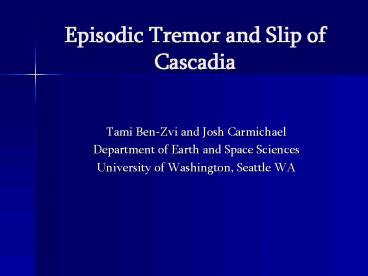Episodic Tremor and Slip of Cascadia - PowerPoint PPT Presentation
1 / 13
Title:
Episodic Tremor and Slip of Cascadia
Description:
Slow-slip events: GPS measured, cyclic deformation transients ... Seismic chatter and slip correlate temporally. Intermittent periods almost seismically quiet ... – PowerPoint PPT presentation
Number of Views:22
Avg rating:3.0/5.0
Title: Episodic Tremor and Slip of Cascadia
1
Episodic Tremor and Slip of Cascadia
- Tami Ben-Zvi and Josh Carmichael
- Department of Earth and Space Sciences
- University of Washington, Seattle WA
2
ETS Basic Observations
- Slow-slip events GPS measured, cyclic
deformation transients ? subduction zone
interfacial slip - Tremor and slip activity approximately periodic
Repeat over 1316 month intervals - Seismic chatter and slip correlate temporally
- Intermittent periods almost seismically quiet
Rogers Dragert, 2003
3
Observables from Waveforms
- Waveforms emergent no clear P or S wave
arrivals, non-impulsive - Bulk of energy content in the low frequency
range 1-5 Hz - Hypocenter locations not coincident with plate
interfacewide source depth distribution - Signals travel at shear wave speed
Rogers Dragert, 2003
4
Spatial Temporal Correlation Between Slip and
Tremor Events
- Spatial correlation source located near plate
interface. - Temporal correlation tremors detected near slip
events, fewer or no tremors detected between slip
events.
5
Dynamics Suggestions
- Fluid migration accelerated by slip ?
- Pore-pressure increase followed by volumetric
strain energy release in small earthquakes? - Localized expansion from serpentinization
inducing microfractures? - J.R.Rice No fluids needed! Depth and rate
dependent friction, with pore pressure, predicts
spontaneous aseismic slip on subducting interface
6
The Depth and Rate Dependent Slip Model
Pictorial summary
Taken from Lui and Rice, 2005 (Journal Geophys.
Research Volume 10)
7
The Basic Physics
8
Simulation Results
Type I transients
Type II transients
Reduce locking nucleation
9
Characteristics
- Occurrence is on the order of 100 years of last
seismic event - TI Coalescence of two transient slip fronts
after 30 years. - TII Stress transfer creates multiple
transients displays nucleation, and relocking
slip velocity O(10Vplate) - Reduced locking may create large-slip nucleation
sites
10
Comparisons
- Slip velocities 10-7-10-9 m/sec calculated in
model comparable from Cascadia (Dragert 2001) - Depth range transient activity occurs toward
down-dip end of seismogenic zone - Transients migrate along strike at O(10km/sec)
year. Smaller Lf or larger pore pressure ?
faster transient migration speeds.
11
Fluid related source modelFluid-flow-induced
oscillations
- Model Assumptions
- Single phased, constant density
- fluid
- 1D/2D motion
- Elastic conduit w/width change in time
- Conservation of mass and momentum of fluid gt 3rd
order of non-linear diff. equations
Julian, 1994
Cyclic Behavior Bernoullis theorem p(rv2)/2
const Big vgtsmall pgtwalls move closergtp builds
up
Chaotic behavior period doubling cascade -
almost noisy looking time series.
12
Fluid related source modelExcitation of
fluid-filled cracks
Model by Chouet (1986, 1988) Crack wall
displacement caused by sustained fluid pressure
disturbance. Oscillation modes 2L/n, 2W/n
n2,3,4, Unsteady shock wave near crack
caninduce pressure disturbance and oscillations.
Konstantinou, 2002
13
Summary Possible Mechanisms































